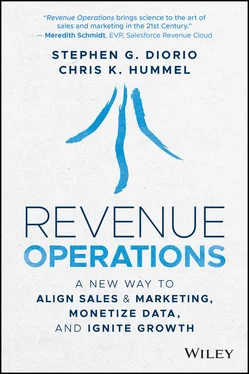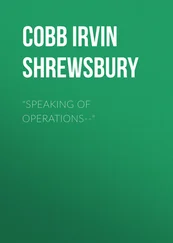Stephen Diorio - Revenue Operations
Здесь есть возможность читать онлайн «Stephen Diorio - Revenue Operations» — ознакомительный отрывок электронной книги совершенно бесплатно, а после прочтения отрывка купить полную версию. В некоторых случаях можно слушать аудио, скачать через торрент в формате fb2 и присутствует краткое содержание. Жанр: unrecognised, на английском языке. Описание произведения, (предисловие) а так же отзывы посетителей доступны на портале библиотеки ЛибКат.
- Название:Revenue Operations
- Автор:
- Жанр:
- Год:неизвестен
- ISBN:нет данных
- Рейтинг книги:3 / 5. Голосов: 1
-
Избранное:Добавить в избранное
- Отзывы:
-
Ваша оценка:
- 60
- 1
- 2
- 3
- 4
- 5
Revenue Operations: краткое содержание, описание и аннотация
Предлагаем к чтению аннотацию, описание, краткое содержание или предисловие (зависит от того, что написал сам автор книги «Revenue Operations»). Если вы не нашли необходимую информацию о книге — напишите в комментариях, мы постараемся отыскать её.
Revenue Operations: A New Way to Align Sales and Marketing, Monetize Data, and Ignite Growth
Revenue Operations
Revenue Operations
Revenue Operations — читать онлайн ознакомительный отрывок
Ниже представлен текст книги, разбитый по страницам. Система сохранения места последней прочитанной страницы, позволяет с удобством читать онлайн бесплатно книгу «Revenue Operations», без необходимости каждый раз заново искать на чём Вы остановились. Поставьте закладку, и сможете в любой момент перейти на страницу, на которой закончили чтение.
Интервал:
Закладка:
Cover Images: Courtesy of Chris K. Hummel; © koosen/Shutterstock; © Ollustrator/Getty Images
Cover Design: Wiley
Acknowledgments
We are grateful to the many people who took the time to share their thoughts and experiences with us. So many people helped us along the way who have our heartfelt thanks, and that list inevitably goes far beyond the people listed here. The leading minds in the science of growth from business, academia, consulting, technology, and association worlds participated in and supported this work.
That starts with all the executives and CXOs who graciously provided such detailed insight, anecdotes, and stories. Your real-world experience is the backbone of Revenue Operations. This includes the ongoing advice and real-world perspective from our network of executives who have led Fortune 500 sales and marketing organizations, including: Toni-Clayton Hine (EY), David Edelman (Aetna), Peter Horst (Hershey), Denise Karkos (Sirius XM), Shannon LaPierre (Stanley), David Master (Janus Henderson), Mike Marcellin (Juniper Networks), Jaime Punishill (Lionbridge), Steve Shannon (Kia Motors), and Connie Weaver (The Equitable). A big “thank you” to the hundreds of other executives we spoke with who are out there fighting to add science to the art of growth. This book is anchored by research, lessons, and insights from leaders of Analytics@Wharton at the Wharton School of Business, including Professors Eric Bradlow, Kartik Hosanagar, Raghu Iyengar, Leonard Lodish, David Reibstein, and Abraham Wyner.
We loved learning from several leading academics in the science of growth over the last five years. We are grateful to receive insights, research, and education from Neil Bendle (Terry College of Business), Bobby Calder (Kellogg School of Business), Paul Farris (Darden School of Business), Dominique Hanssens (UCLA Anderson School of Business), Peter Howard (Questrom School of Business), Purush Papatla (Northwest Mutual Life Big Data Institute), Don Sexton (Columbia Business School), Dave Stewart (Loyola Marymount University), and Kimberly Whitler (Darden School of Business).
Our research would have been impossible without access to experts who have helped hundreds of businesses become more data driven, accountable, and productive, including Howard Brown, Cam Tipping, and Neil Hoyne. This also includes key friends like Ian Lowles, Bill Wohl, Rick Devine, Rob Halsey, and Anthony Johndrow and others who provided counsel on the ideas and models we built.
We drew heavily from the Marketing Accountability Standards Board (MASB), and in particular their leaders Frank Findley and Tony Pace, who are doing the hard work of proving the financial contribution of growth assets and investments.
We learned critical lessons on breaking silos, aligning revenue teams, and creating a common purpose across the organization from General Stanley McChrystal and Victor Bilgen of the McChrystal Group.
We also received generous perspective and advice from the leading analysts in the sales and marketing technology sphere, including Brent Adamson of the Gartner Group and Rich Eldh, the Founder of Sirius Decisions
This research leaned very heavily on the decades of experience from the leadership of Blue Ridge Partners, an elite go-to-market consultancy. We relied heavily on the experience, judgment, and research of Jim Corey, Carter Hinkley, Marten Leijon, Allen Merrill, Jim Quallen, Michael Smith, and Corey Torrence.
We received tremendous support and access to research and executives' perspectives from the leading associations and professional organizations in the field of growth, notably: Bob Liodice of the Association of National Advertisers, Bob Kelly of the Sales Management Association, and Earl Taylor of the Marketing Science Institute.
We are indebted to the team that sponsored and guided the production of this book, including Richard Narramore, our editor at John Wiley and Sons, and his crack editorial, production, and marketing team that kept us on task and on time, including Jessica Filippo, Deborah Schindlar, and Donna J. Weinson.
Researching a book takes a tremendous amount of analysis and digging. Heartfelt thanks to our research team that analyzed thousands of technology solutions, including Blake Brown, Robert Diorio, Jeff McKittrick, and Greg Munster.
We needed the painful and valuable contribution of our crack editing team, including Ingrid Wenzler, Adam Sirgony, and Matthew Schmitd, plus special contribution from my brilliant daughter Anna Diorio, who added elegance to our visuals and storytelling.
Of course, none of this could have happened without the personal support and encouragement of our families. They were strong enough to push us when challenges seemed insurmountable and were gracious enough to give us the space we needed when we hit our stride. We are blessed to have our spouses, Lyn and Tatiana, who provided the support, motivation, food, and “air cover” to make this book possible. Our children, Anna and Robert and Angelina, Dante, Chris Jr, and Arabella, should all take credit in this, too, for the inspiration they provide us every day.
Introduction
Growth is good. Really good.
Growth elevates short-term performance. Growth has a disproportionate effect on valuation. Growth – especially organic growth – generates intangible goodwill and positive momentum among customers, influencers, analysts, and employees.
Here's the challenge: organizations too often treat growth like a disconnected, functionally driven art form rather than the interdisciplinary, data-driven science it should be.
The core revenue-facing functions – Marketing, Sales, and Service – all operate in silos. Each function is trying to do its individual job and maximize the impact of its activities on customers and revenue. Managers optimize the parts – brand, demand generation, pipeline conversion, retention rates, etc. – while coordination between the three is episodic, temporary, and heavily influenced by the personalities involved. They allocate resources as a cascade along organizational lines using historical precedents as the primary guide.
Even when this approach works, managers generally celebrate only the fact that growth happened, since they usually cannot explain why. Teams assume that someone else will take responsibility for the whole. When cross-functional collaboration happens, it requires Herculean efforts to marshal the collective troops and achieve one-time, almost artisanal objectives.
Who is ultimately responsible for coordination of key growth assets and initiatives in the business? That often falls on one person: the CEO. Because no other c-level officer typically controls more than 40% of the identified 18 levers of growth, CEOs get dragged into the nitty-gritty of optimizing all variables that cross organizational boundaries. There are a lot of these. Organizations may be built around functions, but real-world opportunities and challenges ignore those artificial boundaries.
So, we have functional experts trying to manage an interdisciplinary, multifaceted problem. This gap between the importance of growth to firm value and the limited understanding of how to achieve it creates heated discussions in boardrooms, management meetings, and planning sessions everywhere. What are we all missing?
Today we lack a system for growth.
Such systems for the back office and supply chain have already been developed over decades. It's time that we brought similar discipline, rigor, and methodology to the process of expanding our revenues. The three teams involved work hard and do their best, but somehow things just aren't clicking. The front office needs standardization and repeatability, too.
To understand how a systems-based approach to growth might work, let's look at what's happening inside each of the revenue-centric functions. To start, here are some common problems all functions are faced with:
Читать дальшеИнтервал:
Закладка:
Похожие книги на «Revenue Operations»
Представляем Вашему вниманию похожие книги на «Revenue Operations» списком для выбора. Мы отобрали схожую по названию и смыслу литературу в надежде предоставить читателям больше вариантов отыскать новые, интересные, ещё непрочитанные произведения.
Обсуждение, отзывы о книге «Revenue Operations» и просто собственные мнения читателей. Оставьте ваши комментарии, напишите, что Вы думаете о произведении, его смысле или главных героях. Укажите что конкретно понравилось, а что нет, и почему Вы так считаете.











